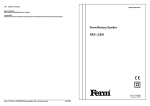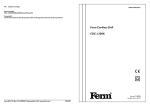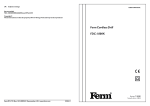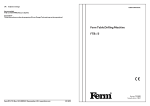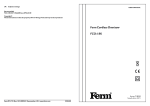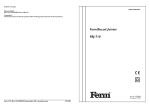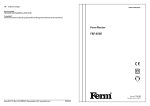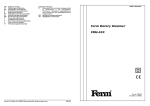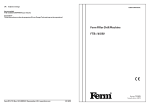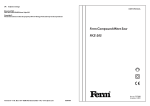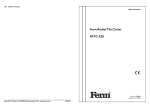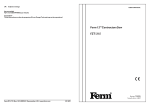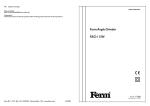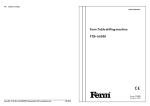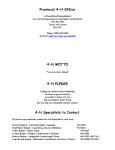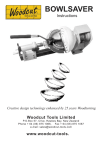Download Ferm Wood Lathe FHB-940
Transcript
UK Subject to change USER’S MANUAL Document Ref: FHB-940/15092/PMR43/Issue 1/July 02 Copyright © These instructions are the sole property of Ferm-Omega Tools and may not be reproduced Ferm Wood Lathe FHB-940 Art.nr. 760140 Screwfix Art.nr. 15092 Ferm BV • P.O. Box 134 • 8280 AC Genemuiden • NL • www.ferm.com 0211/06 SAFETY INSTRUCTIONS The following pictograms are used in these instructions for use: FERM WOOD LATHE FHB-940 USERS MANUAL TECHNICAL SPECIFICATIONS Voltage Frequency Power Noload speed (-/min) Number of speeds Headstock / morse taper & threaded Tailstock / morse taper Overall dim (mm) Weight PRODUCT INFORMATION | | | | | | | | | | 230 V~ 50 Hz 370 W 480-3010 5 No.1, 3/4-16 No.1 375x400x308 38 kg EXPLODED VIEW Denotes risk of personal injury, loss of life or damage to the tool in case of non-observance of the instructions in this manual. Denotes risk of electric shock. Carefully read this manual before using the machine. Make sure that you know how the machine functions and how to operate it. Maintain the machine in accordance with the instructions to make sure it functions properly. Keep this manual and the enclosed documentation with the machine. Ferm products are manufactured to high quality standards, they are safe and fit for purpose at time of sale, but all tools can be dangerous if the correct precautions are not taken. Always follow these instructions, do not carry out the operation until you are sure you can do so in safety. Remember to consider the work environment for safe operation as well as safety for tool use. Warning! When using electric tools, basic safety precautions should always be followed to reduce the risk of fire, electric shock and personal injury. Read all these instructions before attempting to operate this product. Save these instructions for future reference. A. B. C. E. F. G. H. I. L/M. P. Headstock Bed tubes (b1 and b2) Tailstock Foot Bed bolt Tailstock barrel lock wheel Saddle Toolrest support Tool rests Faceplate PERSONAL SAFETY Use Personal Protection Safety Equipment Protect eyes with safety glasses or goggles note: the use of safety protective eyewear without the CE mark can lead to serious injury if the lens breaks. A suitable dust mask should be worn if cutting, drilling or sanding is dusty, in particular chipboard or MDF. Approved safety footwear and headgear should worn as appropriate, for example on building works or when heavy weights are involved. Wear suitable clothes to protect against shavings/ debris. Wear earplugs or ear defenders. Dress properly Do not wear loose clothing or jewellery. It can get caught in moving parts. Non-skid footwear is recommended when working out doors. Wear protective hair covering to contain long hair. Stay alert Watch what you are doing. Use common sense. Do not operate tools when tired or after taking alcohol or prescription/ non-prescription drugs. 2 Ferm SPARE PARTS LIST FHB-940 REF NR 45 23 3 41 43 55 57 58 61 64 75 Ferm DESCRIPTION V-BELT SWITCH MOTOR HEADSTOCK SPINDLE SPUR CENTRE QUICK-ACTING KEY TOOL SUPPORT HOLDER TOOL SUPPORT SREW HANDLE CUP CENTRE PUSHER FERM NR 800170 406103 406102 406104 406105 406106 406107 406108 406109 406110 406111 11 GUARANTEE The guarantee conditions can be found on the separately enclosed guarantee card. CEı DECLARATION OF CONFORMITY OPERATIONAL SAFETY Warning! This machine can produce fine dust, which can be harmful to your health. Always wear a suitable dust mask and other protection equipment as appropriate. Use dust extraction. (UK) Concentrate Routine and repetition can lead to mistakes. Remember that a slight lack of concentration can result in serious injuries in a split second. We declare under our sole responsability that this product is in conformity with the following standards or standardized documents Keep work area clean Cluttered areas and benches invite injuries. EN61029-1, EN61000-3-2, EN61000-3-3, EN55014-1, EN55014-2 Consider the work environment Do not expose power tools to rain or use them in damp or wet locations. Keep work area well lit. Do not use power tools in the presence of flammable liquids, vapours or gases. in accordance with the regulations: 98/37EEC 73/23EEC 89/336EEC Guard against electric shock This unit contains dangerous voltages. Use a RCD (residual current device) to provide protection against electrical shock. Prevent body contact with grounded surfaces (e.g. pipes, radiator, ranges or refrigerators). from 26-05-1998 GENEMUIDEN NL W. Kamphof Quality department Keep children and pets away Do not let children or pets come into contact with the tool, extension cable or work area. Do not force the tool It will work better and safer at the rate for which it was intended. Avoid unintentional starting Do not carry plugged in tools with your finger on the switch. Check that the switch is off before plugging in to the socket. Extension cables Use only three core earthed extension cables suitable for the power input of the tool (minimum cable size 1.5mm2). Plug into an earthed socket only. When using a cable reel unwind it fully. Do not use long extension cables. Outdoors use If the tool is suitable to be used outdoors, only use an extension cable intended for outdoor use and marked accordingly. Use a RCD (residual current device) to provide protection against electrical shock. Do not use in rain or damp conditions. Connect a dust extraction device Whenever there are facilities for fitting a dust or fume extraction system, make sure it is connected and used. Use recommended accessories The use of any other accessory or attachment other than recommended in the instructions or catalogue may present a risk of personal injury. Extension cables Use extension cables suitable for the power input of the lathe (minimum cable size 1.5mm2, maximum cable length 20 metres). Only connect to an earthed socket When using a cable reel unwind the cable fully. Use the right tool Do not force small tools or attachments to do the job of a heavy-duty tool. Do not use tools for purposes for which they were not intended; for example do not use a circular saw for cutting trees or logs. Do not abuse the cable Never carry the tool by the cable or pull it to disconnect it from the power socket. Keep the cable away from heat, oil and sharp edges. Do not touch the metal plug pins when connecting or removing the plug. Secure Work Use clamps or a vice to hold work. It is safer than using your hand and it frees both hands to operate the tool. Do not over-reach Keep a proper footing and balance at all times. Disconnect tools from power supply When not in use, before servicing and when changing accessories such as bits and cutters. Always switch off and unplug the lathe from the power supply before making adjustments or changing the work piece. Remove adjusting keys and wrenches Ensure that they are removed from the tool before switching on. 10 Ferm Ferm 3 BEFORE USING THE LATHE This lathe must be fully assembled before use. If you have not used a wood lathe before, make sure you fully understand the machine and operating procedures before using it. Beginners can seek help and advice from instructors, local technical collage courses or from professionals. Study the machine’s parts layout in fig 1 page 2, before proceeding with the assembly. This is a heavy machine; it weighs 38kg in total, so get someone to help you unpack and install it. ASSEMBLY Check package contents Check contents against list in this manual to make sure each item is present. Check for damage Before using this item check each part listed is undamaged. Save packaging Save major packaging for return of product for service or repair. Mount on a bench Ensure the lathe is not plugged into the mains and is switched off. This machine must be mounted on and secured to a level stable bench. Before proceeding make sure the bench is strong enough and is fixed to wall/floor securely. • Make sure the bench is the right height (the height of the headstock spindle should be about level with your elbow when mounted on the bench) and there is sufficient space on and around the bench to mount and operate the lathe. Mount the headstock on the bench • Drill two 10mm holes as detailed in fig 2 below. Make sure that the holes have clear space underneath the bench so you can tighten the fixings nuts. • Put the head stock assembly (A) on the bench and secure with suitable 8mm bolts/washers/lock washers and nuts (not supplied). Tighten the bolts finger tight only at this stage. Make sure the washers/lock washers are on the nut end of the bolt. Assemble the lathe bed halves • Remove the loose rail grub screw from b2 and assemble the two halves (b1 and b2) by sliding b1 (plugged end with threaded hole in it) into b2. • Insert the foot (E) into the open end of b2 and push the bed bolt (F) through the foot and b2 until it connects with the threaded hole in b1. Screw the bed bolt in a few turns but no not tighten it yet. • Align the metal rails on the bed tubes and reinstall the rail grub screw, check the bars are aligned with a straight edge and tighten the grub screw with a suitable crosshead screwdriver (not supplied). Check for damaged parts Do not use a tool with damaged parts, before further use a damaged tool must be carefully checked by a qualified person to determine that it will operate properly. Check for alignment of moving parts, binding or breakage of parts, mounting and other conditions that may affect its operation. A damaged part or guard should be properly repaired by an authorised service centre, unless indicated otherwise in the instruction manual. Have defective switches replaced by an authorised service centre. Do not use a tool if the switch does not turn on and off. Note: The tubes and rails must be exactly aligned to enable the tailstock and saddle to slide over them. Have your tool repaired by an expert This appliance is manufactured in accordance with relevant safety standards. Only experts must carry out repairing of electrical appliances, otherwise considerable danger for the user may result. • Position the foot so that the rails will face straight downwards when it’s bolted to the bench. Assemble the bed assembly to the headstock • Slide the tailstock (G) over the bed tube with the plain end of the tailstock barrel facing the headstock. • Slide the saddle (H) over the bed tube with flat side up. • Make sure the grub screw (facing the motor) in the headstock is loose then slide the whole bed assembly into the headstock. • Push the bed tube into the headstock until it hits the stop. • Position the whole assembly so that the foot sits square an the bench, check the bed tube is fully home in the headstock then tighten the grub screw with the 4mm Allen wrench supplied. • Check that the saddle and tailstock slide over the joint in the bed tubes and the foot is flat on the bench, if not readjust the tubes and rails until they are aligned properly. • Tighten the bed bolt with a suitable 16mm spanner (not supplied). Storing tools When not in use tools should be stored in the dry, out of reach of children. LUBRICATION All the bearings are packed with grease for life and require no user lubrication. Lubricate the tailstock barrel with light oil occasionally. Spray the unprotected metal parts with light rust resistant oil occasionally. A coat of car polish on the bed tubes helps keep them clean and protected. ELECTRICAL INFORMATION This product is complete with a pre-wired mains plug. If the plug needs replacing follow these instructions. Wire correctly The wires in the mains lead are coloured in the following way: BLUE • Neutral BROWN • Live GREEN/YELLOW • Earth Securing wires Secure wires carefully and firmly to the correct terminals. Secure the mains cable in the plug cord grip firmly Fit a 5-amp fuse. If a 13amp (BS1363) plug is used a (BS 1362) ASTA approved 5-amp fuse must be fitted. Recycle/Dispose of old plug and cable Prevent inadvertent connection to socket and risk of electric shock ENVIROMENT Recycle the packaging according to the identification marks on it. At the end of the product or its accessories life please recycle where facilities exist. Phone the Helpline for current advice on recycling. Helpline For any questions relating to operational or safety matters contact: Ferm Customer Helpline on: 0115 966 1199 Monday-Friday 8am – 6pm Saturday 9am – 1 pm Secure the foot and headstock to the bench • Mark the position of the holes in the foot and drill two 10 mm holes in the bench. • Check that the whole lathe assembly sits square and level on the bench, if it does not, use packing pieces as necessary • Secure the foot to the bench with 8mm bolts/washers/lock washers and nuts. • Make sure the washers/lock washers are on the nut end of the bolt then tighten with a suitable spanner (not supplied). • Tighten the nuts securing the headstock to the bench. Fit the lock bolts Supplied with the lathe are five locking bolts, two washers and two brass slugs, they are for locking the adjustment on the saddle, tailstock and toolrest. • The brass slugs prevent wear/damage on the lathe bed and must be inserted into threaded hole before the locking bolt is screwed in the positions shown. • The washers are used with the locking bolt with the knurled handle to secure the adjustment on the saddle/toolrest support. 4 Ferm Ferm 9 GETTING STARTED ON A PROJECT If you have little or no experience with woodturning we recommend you get some instruction or consult a good book on the subject before you start. A very suitable book for beginners is: ‘Woodturning – A Foundation Course’ by Keith Rowley available from The Guild of Master Craftsman by post. Phone: +44 (0) 273 477 374 for details. Below are the first basic steps for spindle turning Be sure you have studied and understand this operation manual before you start. • • Select a piece of softwood without any knots, cracks or other defects 300x50x50mm. Draw diagonal lines on each end to locate the centres as in fig 11 below. MAINTENCE, CARE AND REPAIR Switch off and unplug the machine before carrying out any cleaning, adjusting or maintence tasks. CLEANING Clean the lathe with a soft brush. Do not use flammable liquids to clean the lathe, they can damage the plastic parts and are a fire risk. Clean shavings and dust from the machine and the area around it regularly, do not allow them to build up. They are a fire risk. FAULTS Switch OFF immediately at the mains plug and remove the plug when: • The plug or cable is damaged. • The switch on the machine is defective. • You smell or see smoke caused by scorched insulation in the machine. The motor runs hot (over 70 degrees C) • The motor has been overloaded. Cut more slowly. • Remove sawdust from vents and inside machine. • The motor is defective, Take to your local dealer for repair. • • • • • Make a saw cut 1.5mm deep on each diagonal line; this is for the 4-prong drive, on the other end gently tap the live centre’s point into the wood at the intersection of the diagonal lines. Check the lathe set up and mount the drive and live centres as previously described. Attach the wood to the lathe. Make sure the centres are located and the adjustments and locking bolts are tight. Adjust the toolrest so that it’s parallel with the wood with a 3mm gap and the top of the rest is 3mm above the centreline – tighten the locking bolts. Set the lathe at its slowest speed. Before you start the lathe: • Check you have a sharp roughing gouge about 25mm wide, you are wearing the appropriate safety equipment, revolve the wood by hand, stand to one side and you are ready to switch on and start your project. Think Safety and use your common sense. 8 Fig 8 below shows the position of the brass slugs and all the locking bolts. Adjust the tailstock to lathe bed The tailstock has an adjustment screw, which is situated below the tailstock-locking bolt. Refer to fig 6 below and adjust as follows: • Use the 4mm Allen wrench (supplied) to screw this screw in until it just touches the rail on the underside of the lathe bed, then undo it of a turn. • Slide the tailstock up and down the bed and turn the screw in gradually until the tailstock moves easily but without any sideways movement, this completes the adjustment. The lathe does not work when switched on • Damaged plug/fuse. Replace as required. • Defective switch. Take to local dealer for repair. • Burnt out motor. Take to local dealer for replacement. The lathe slows when turning • The belt is loose. Adjust as previously described. The tailstock moves back and forth • Adjust the tailstock to bed and lock grub screw. There are no user serviceable/repairable parts inside this unit. Qualified service engineers must carry out repair and servicing. MAINTAIN TOOLS WITH CARE Keep the tool clean for better and safer performance. Store the accessories properly in accordance with the maker’s instructions. Follow instructions for changing accessories. Inspect tool and extension cables periodically and if damaged, have them repaired by a qualified person or authorised service body. Keep handles free from oil or grease. Keep the ventilation slots clean to prevent the motor overheating. Ferm Fit the drive center and the live center The 4-prong drive center fits into the No 1 Morse taper in the headstock spindle. • Remove any grease or oil from the drive center and the inside of the spindle and push and twist the drive center into the spindle. Take care the points and prongs are sharp! • Fit the live center into the tailstock barrel in the same way. Note: Do not tap the drive/live centers home with a hammer. It will make them difficult to remove. To remove the drive and tailstock centers • Remove the drive center by turning the nut on the headstock spindle with a 27mm spanner (not supplied) until the drive center is ejected. • Remove the tailstock center by putting a 6mm round wood dowel or brass rod into the end of the tailstock barrel and gently tapping it with a hammer while holding the tailstock center. Ferm Align the head and tailstock centers To align the centers refer to fig 7 below and adjust as follows. • Slide the tailstock towards the headstock so that the centers are very close but not touching. • Tighten the tailstock barrel lock wheel and the tailstock-locking bolt. • Loosen the bed tube locking grub screw in the headstock with the 4 mm Allen wrench. • Move the tailstock sideways until the points of the drive centers are aligned. • Tighten the bed tube locking grub screw securely. Fitting the faceplates The lathe is delivered with two faceplates. One is marked ‘IN’ which is used on the inboard end of the headstock spindle - assemble as follows: Fit the inboard faceplate • Locate the spindle lock device just to right of the inboard end of the headstock spindle and pull it out and turn 90 degrees. This will unlock or unlock the headstock spindle. • Make sure the headstock spindle is locked then screw the faceplate clockwise onto the thread on the headstock spindle, flat face outwards. Secure with the headstock spindle nut hand tight. Do not tighten more than this, as it will make the faceplate difficult to remove. • Unlock the headstock spindle. Fit the outboard faceplate The other faceplate is marked ‘OUT’ and fits on the other (outboard) end of the headstock spindle. • Remove the bolt securing the belt cover and remove the spindle’s protective cover from the belt cover by pushing the plastic tabs inwards then pushing the protective cover outwards from the inside. • Close the cover and refit the bolt. Note: The cover has a safety interlock, do not override it and under no circumstances operate the lathe with this cover open. • • • Lock the headstock spindle Screw the faceplate into the headstock spindle anticlockwise, flat face outwards hand tight. Unlock the headstock spindle. 5 Note 1: Do not try to switch the lathe on with the spindle locked. Note 2: Refit the headstock spindle cover when not using the outboard faceplate. USING THE LATHE Route the mains lead Keep the mains lead away from the lathe and ensure that it cannot get caught in the workpiece or any moving part and is well away from the work area. BEFORE YOU START • Be sure you understand the instructions and warnings in this manual. • Do not attempt an operation on the lathe until you can do so in safety . Know your limits, an experienced turner may be able to do safely things not recommended for a beginner. • Use the correct speed. Slower speed for larger or rough work pieces and faster for smaller or balanced pieces. • If the lathe shakes or vibrates, lower the speed. • If the work piece vibrates, always stop the lathe and investigate the cause and rectify it before proceeding. • Check the belt cover is in place and secure. • With the lathe switched off rotate the work piece by hand to check that is clears the bed and tool rest. • Check the work piece turns freely and is securely mounted. • Check that all locking bolts are tight. • Use personal protection equipment. Always wear a suitable dust mask, safety glasses and ear defenders, plus other items as appropriate. Do not wear gloves or loose clothes. This lathe is intended for use on wood and wood derived products only. Note: The belt must run parallel, do not install or use it in a diagonal position; this will cause the belt to wear out very quickly. • After adjustment close the belt cover and secure with bolt and washer. OPERATION • Plug into a suitable mains supply and switch on. To switch the lathe ON Depress the green button on the headstock Belt tension adjustment Make sure the lathe is switched off and unplugged. To switch the lathe OFF Depress the red button on the headstock Note: This is a NVR (no volt release switch) and will not operate without the power connected. To Change speed Make sure the lathe is switched off and unplugged. Before and during operation • Always rough out irregular work pieces at slow speed. Do not try to turn large out of round work pieces. • Inspect the work piece for knots, cracks, bark or protuberances if these are present do not use. • Keep the turning tools sharp at all times. • Keep the tool in contact with the toolrest at all times. • Keep the tool handle down and advance the tool slowly towards the revolving work piece. • Do not allow the tool to bite into the work piece; this could result in splitting or the work piece being thrown from the lathe. • Always position the toolrest above the centreline of the lathe when spindle turning (turning between centres). • Do not run the lathe in the wrong direction i.e. away from you, this could result in the faceplate or chuck unscrewing. • Fasten the work piece securely to the faceplate. • Each time you start the lathe, stand to one side of the work piece so if it did become detached it would not hit you. • Keep your tools and accessories in a place convenient place, so you do not have to reach over the revolving work piece to get to them. • Keep proper footing and balance at all times, don’t overreach. • Complete sanding of the work piece before removing from the lathe. • Remove the toolrest when sanding. • Do not remount a faceplate turning; use caution when remounting a spindle turning to original centres always use slow speed when turning a remounted work piece. • Never leave the lathe running unattended. Switch off, unplug and let the machine come to a complete stop first. The belt is tensioned by the weight of the motor, to adjust: • Locate the adjusting bolt with its locknut, which is on the corner of the motor mounting plate. • Slack off the locknut with a 14mm spanner (not supplied) and tighten the bolt to decrease belt tension. Slack off the bolt to increase it. • Tighten the locknut after adjustment. Refer to illustration below. In fig 9 the belt is shown in the second position, this makes the lathe revolve at 2120 rpm (revolutions per minute). Fig 10 below gives the 5 speeds available. • To change the lathe’s speed remove the bolt and washer securing the belt cover with a 14mm spanner (not supplied) • Shift the belt inwards to make the lathe revolve slower and outwards to make it faster. • Rotate the motor pulley anticlockwise with your left hand and push the belt towards the required groove on that pulley with your right hand until it ‘climbs’ into the required groove. • Rotate the motor pulley clockwise and push the belt towards the required groove in the spindle pulley. 6 Ferm Ferm 7






